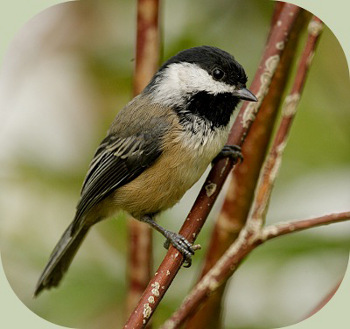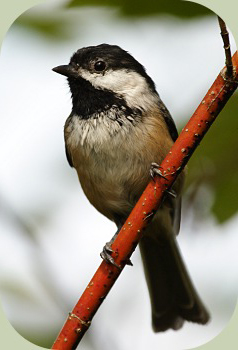Black-Capped Chickadee

Fun-loving, bold and vocal the black-capped chickadee is known and loved by many. But, did you know that they have one of the widest vocabularies of our local songbirds? There are many fascinating aspects to the black-capped chickadee. You may already know something about this bird, but perhaps more formal introductions are in order.
Description of the Black-capped Chickadee
Chickadees all come in a similar package: small rounded bodies, rounded heads, long tails, dark shiny eyes and a small, short, pointed bill. The black-capped chickadee (Poecile atricapillus) has a black cap that comes down to the bottom of the eye and top of the bill. The cheeks are white, and the white continues on to the back of the head and neck. The chin and throat area also have a black triangle, often called a "bib." The upper back and rump is gray-olive, while the wings are generally patterned in subtle shades of gray. Tail is gray, with feathers becoming progressively paler on their edges as you move to the outside of the tail. This chickadee has pale tan or light yellow-brown sides and white chest and belly region.
Size
These little birds are about 5 inches long, with a wingspan of about 8 inches. Their body can appear thicker or thinner depending on their mood or on the weather. Like all birds, chickadees can fluff up or flatten their feathers at will.
Habitat
They are found in a variety of habitats across the country, including: riparian areas, woodlands, mixed forests, orchards, parks, sub-urban and urban areas.
Voice
These birds produce a wide-variety of vocalizations, including: chips, whistles, gargles, and others. The most familiar sound is their chick-a-dee-dee! call that gives them their name. They also sing a bright springtime song that sounds like hi-sweetie! or cheese-burger! Scientists have recognized and described at least 15 different vocalizations made by black-capped chickadees.
Diet
Chickadees spend a great deal of time picking small insects such as caterpillars off of trees. It is not unusually to see them hanging from a branch upside down as they feed! They will occasionally come down to the ground, but generally near the cover of shrubs or low branches. These chickadees will also visit feeders and consume seed and suet.
Nesting
Chickadees are cavity nesters, often using the holes excavated by downy woodpeckers, but also use dead snags and rotten branches. These chickadees will also use nest boxes of the right proportions. Inner chamber is lined with moss and fur or hair. Female incubates up to 8 white, brown spotted eggs for around 13 days.
Be More Prepared For Your Next Outdoor Adventure!

Don't leave home without knowing these six essential survival skills. Our free survival mini guide reveals the strategies of:
- Shelter & fire to prevent the number one cause of death
- Obtaining clean water to avoid life-threatening dehydration
- Common wild survival foods and other critical skills!

Habits
Black-capped chickadees are small, but very hardy birds and do not migrate south during the winter months. During the colder parts of the year, chickadees flock together and travel in larger foraging groups. These flocks often attract other species such as other kinds of chickadees, woodpeckers, nuthatches, creepers, kinglets and other small birds. During the spring and summer, however, chickadees become more territorial and pairs spend more time alone, later with their juvenile young. Chickadees are bold and trusting with people. They are also bold in their behavior towards potential predators such as roosting owls, and will scold them loudly when the predator is discovered.
Predators
Chickadees have a variety of predators, including northern pygmy owls, saw-whet owls, merlins, kestrels, Cooper’s hawks, Sharp-shinned hawks, house cats, weasels and other predators that eat small birds. Larger predators such as great horned owls, large hawks, cougars and other large carnivores are not generally a threat to chickadees. For more information on two of the main predators of these small birds, check out Sharp-shinned Hawk and Cooper's Hawk: Agile Aerial. Acrobats
Bird Language Notes
Due to their vocal nature, chickadees are a great bird to pay attention to when you want to spot the predators in your area. The level of threat the predator poses to a small bird will be reflected in the level of intensity and frequency of chickadee calls. Specifically, the number of "dees" added to the end of the common chick-a-dee-dee-dee call points to how threatening the particular predator is to small birds like chickadees. The more dee's added, the more dangerous the predator is. Predators such as pygmy owls, that regularly prey on small birds cause the greatest alarm among small birds.
By the way, when you're out birding, it's important to know how to stay safe in the outdoors, especially if you were to get lost. Right now you can get a free copy of our mini survival guide here, where you'll discover six key strategies for outdoor emergencies, plus often-overlooked survival tips.
Resources:
Find out about the courses offered at Alderleaf Wilderness College.
Check out this great information page on the black-capped chickadee at AllAboutBirds.com.
References: Peterson 1990, Bell and Kennedy 2006, Greene, E. & Davis, K. 2005.

About the Author: Filip Tkaczyk is a periodic guest teacher at Alderleaf. He also wrote the field guide Tracks & Sign of Reptiles & Amphibians. Learn more about Filip Tkaczyk.

Return from Black-capped Chickadee back to Birding Articles
Is The Essential Wilderness Survival Skills Course Right for You? Take the "Online Survival Training Readiness" Quiz
See for yourself if this eye-opening course is a good fit for you. It takes just a few minutes! Get your Survival Training Readiness Score Now!

Grow Your Outdoor Skills! Get monthly updates on new wilderness skills, upcoming courses, and special opportunities. Join the free Alderleaf eNews and as a welcome gift you'll get a copy of our Mini Survival Guide.

 The Six Keys to Survival: Get a free copy of our survival mini-guide and monthly tips!
The Six Keys to Survival: Get a free copy of our survival mini-guide and monthly tips!
Learn more